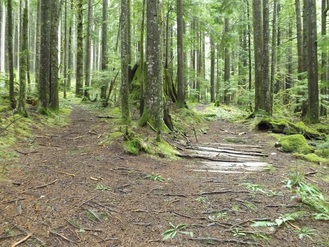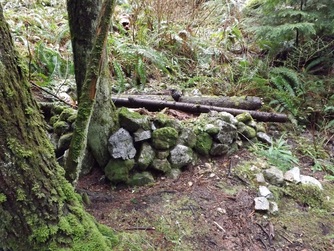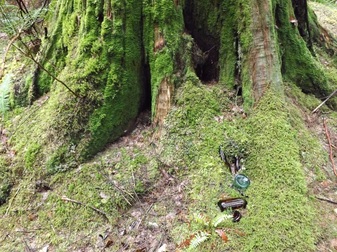McKenzie Creek Japanese Logging Camp
by Elle Glover

The McKenzie Creek Site in North Vancouver is what remains of a Japanese logging camp that was occupied during the early 20th century up until the beginning of World War II. This site is located beside the McKenzie Creek in the Lower Seymour Conservation Reserve.
The McKenzie Creek runs into the Seymour River, which flows down from the watershed located in the Lower Seymour Conservation Reserve in North Vancouver. The Lower Seymour Conservation Reserve is a vast area of forest located at the bottom of Mount Seymour. Studded with creeks, rivers and lakes this area is now a popular place for outdoor activities such as hiking, biking, and fishing. However, this was not always the case. In the early twentieth century, until roughly the beginning of world war two, the Lynn Valley was being logged. The McKenzie Creek site specifically is thought to have been owned by Eikichi Kagetsu, a Japanese immigrant who bought stretches of land in British Columbia for logging in the early 1900s.
This site, along with others in the Lower Seymour Conservation Reserve, was excavated by Professor Robert Muckle and the historical archaeology field school Capilano College. The excavation started in 1999 and continues into the present day. Archaeological work in this area gives insight into turn of the century logging practices in North Vancouver as well as into the lives of the Japanese people in this region.
The McKenzie Creek site is one of two areas thought to have been bought by Kagetsu. The other is the Suicide Creek Camp, also in the Lower Seymour Conservation Reserve. These sites have similar artifacts and features indicating that they were both logging camps occupied by Japanese workers. The sites were both occupied from the early 1900s to the beginning of the Second World War. Due to the fact that the occupants of the sites were of Japanese descent, and the time the sites were abandoned, archaeologists think that the disappearance of the inhabitants of these sites may have been due to the internment of Japanese people in Canada during World War II.
The McKenzie Creek runs into the Seymour River, which flows down from the watershed located in the Lower Seymour Conservation Reserve in North Vancouver. The Lower Seymour Conservation Reserve is a vast area of forest located at the bottom of Mount Seymour. Studded with creeks, rivers and lakes this area is now a popular place for outdoor activities such as hiking, biking, and fishing. However, this was not always the case. In the early twentieth century, until roughly the beginning of world war two, the Lynn Valley was being logged. The McKenzie Creek site specifically is thought to have been owned by Eikichi Kagetsu, a Japanese immigrant who bought stretches of land in British Columbia for logging in the early 1900s.
This site, along with others in the Lower Seymour Conservation Reserve, was excavated by Professor Robert Muckle and the historical archaeology field school Capilano College. The excavation started in 1999 and continues into the present day. Archaeological work in this area gives insight into turn of the century logging practices in North Vancouver as well as into the lives of the Japanese people in this region.
The McKenzie Creek site is one of two areas thought to have been bought by Kagetsu. The other is the Suicide Creek Camp, also in the Lower Seymour Conservation Reserve. These sites have similar artifacts and features indicating that they were both logging camps occupied by Japanese workers. The sites were both occupied from the early 1900s to the beginning of the Second World War. Due to the fact that the occupants of the sites were of Japanese descent, and the time the sites were abandoned, archaeologists think that the disappearance of the inhabitants of these sites may have been due to the internment of Japanese people in Canada during World War II.

One of the many interesting things about the McKenzie Creek site in particular is that, although the inhabitants of most logging camps in this time period were single men, evidence of women has been found. Things such as lipstick tubes and jars of Pond’s Cold Cream most likely belonged to the wives of the loggers rather than the men themselves. The archaeologists researching this site think that children also may have lived in this area, making this camp an area where families lived. This is reflected in the material culture found at the site.
A large number of features and artifacts have been recorded at the McKenzie Creek site over the years. The site encompasses many features that, although may not immediately be apparent to the passerby, if one takes the time to look around, things like the stumps of old growth trees, and the remains of a cedar plank road are not difficult to spot. Remnants of logging activities such as these old growth trees and the cedar plank road (used for the transport of logging equipment from place to place) are all over the Lower Seymour Conservation Reserve. Stumps of old growth trees bearing holes too geometric to be natural can be seen from trails. Nurse logs, perhaps felled during the time this area was logged provide space for new plants to grow. At the McKenzie Creek site itself archaeologists have uncovered the remains of a dwelling, a latrine, and a well. There is also a stone walled structure whose use is as of yet still unknown although there has been speculation as to its purpose based on the artifacts found inside. Nails found around it indicate that the structure at one point had more to it that the low stone walls that remain. Archaeologists are still unsure as to whether the structure was some kind of storage shed or something more.
A large number of features and artifacts have been recorded at the McKenzie Creek site over the years. The site encompasses many features that, although may not immediately be apparent to the passerby, if one takes the time to look around, things like the stumps of old growth trees, and the remains of a cedar plank road are not difficult to spot. Remnants of logging activities such as these old growth trees and the cedar plank road (used for the transport of logging equipment from place to place) are all over the Lower Seymour Conservation Reserve. Stumps of old growth trees bearing holes too geometric to be natural can be seen from trails. Nurse logs, perhaps felled during the time this area was logged provide space for new plants to grow. At the McKenzie Creek site itself archaeologists have uncovered the remains of a dwelling, a latrine, and a well. There is also a stone walled structure whose use is as of yet still unknown although there has been speculation as to its purpose based on the artifacts found inside. Nails found around it indicate that the structure at one point had more to it that the low stone walls that remain. Archaeologists are still unsure as to whether the structure was some kind of storage shed or something more.

The artifacts collected at the McKenzie Creek site vary from things found in a household to tools used in early 20th century forestry practices. Objects such as cans of baby power, jars of cold cream, and tubes of lipstick point to the possibility that the dwellings found were family ones, not those of single men working for the logging industry. Other finds include bottles and kitchen wares whose designs reflect the inhabitant’s Japanese origins. Ceramic plates, and sake bottles are among the more obvious items that point to this camp being Japanese. Most other artifacts found are those that would be found around any logging camp in the early 20th century. Things like nails, barrel ties, and broken saw blades are quite common in these sites as they would have been left or discarded as they broke, or over time rotted out of the structures they once held together.
Sites such as the McKenzie Creek logging site are an important part of Vancouver’s heritage. Sites in this area are used as a teaching tool as well as a way for academics to gain insight into the past. The historical archaeology sites as well as their artifacts are shown to students from schools in the area in order to educate children about the history that is all around them. This is a very important step in public education about Vancouver’s heritage an archaeological sites so that in the future both are protected and preserved.
Some problems archaeologists encounter while excavating a site such as the McKenzie Creek logging camp, that is so easily accessible to the public are litter and other materials left behind by modern day human activity. Hikers and other people walking through the trails have been known to come across sites such as this one, whether they know it or not, and leave things like garbage from food and other waste produced by people pursuing outdoor activities. Perhaps programs like the community archaeology initiative will help prevent problems like these in the future.
Sites such as the McKenzie Creek logging site are an important part of Vancouver’s heritage. Sites in this area are used as a teaching tool as well as a way for academics to gain insight into the past. The historical archaeology sites as well as their artifacts are shown to students from schools in the area in order to educate children about the history that is all around them. This is a very important step in public education about Vancouver’s heritage an archaeological sites so that in the future both are protected and preserved.
Some problems archaeologists encounter while excavating a site such as the McKenzie Creek logging camp, that is so easily accessible to the public are litter and other materials left behind by modern day human activity. Hikers and other people walking through the trails have been known to come across sites such as this one, whether they know it or not, and leave things like garbage from food and other waste produced by people pursuing outdoor activities. Perhaps programs like the community archaeology initiative will help prevent problems like these in the future.
For Further Information See:
Muckle, Robert. "- Community Archaeology in the Seymour Valley, British Columbia: A Joint Initiative of Capilano College and the Greater Vancouver Regional District. Teaching Anthropology: SACC Notes 9.1 (2002): 17. Web. 20 Mar. 2013
http://centre.nikkeiplace.org/volume-10-2005/
http://www.bellacoolamuseum.ca/en/digital_heritage/logging/history_of_logging.pdf
University of Washington Digital Collections
http://www.metrovancouver.org/services/parks_lscr/lscr/Pages/default.aspx
http://archaeologyfieldschool2012.blogspot.ca/2012_05_01_archive.html
http://centre.nikkeiplace.org/volume-10-2005/
http://www.bellacoolamuseum.ca/en/digital_heritage/logging/history_of_logging.pdf
University of Washington Digital Collections
http://www.metrovancouver.org/services/parks_lscr/lscr/Pages/default.aspx
http://archaeologyfieldschool2012.blogspot.ca/2012_05_01_archive.html
Works Cited
Boucher, Yan, Dominique Arseneaul, and Luc Sirois. "Forest Ecology and Management." Elsevier 258.7 (2009): 1359-368. Web. 20 Mar. 2013.
Muckle, Robert. “Community Archaeology in the Seymour Valley, British Columbia: A Joint Initiative of Capilano College and the Greater Vancouver Regional District.” Teaching Anthropology: SACC Notes 9.1 (2002): 17. Web. 20 Mar. 2013.
Muckle, Robert. The Seymour Valley Community Archaeology Project, 2000-2010 An Overview of Sites Investigated, the Artifact Collection, Education, and Research. Vancouver: Capilano University, n.d. Print.
Smedman, Lisa. "Secrets of the Woods:" Vancouver Courier: 0. Nov 24 2002. ProQuest. Web. 25 Mar. 2013 .
White, Evelyn C. "Japanese Internment Revisited." Herizons 2013: 41-. ProQuest. Web. 25 Mar. 2013 .
Muckle, Robert. “Community Archaeology in the Seymour Valley, British Columbia: A Joint Initiative of Capilano College and the Greater Vancouver Regional District.” Teaching Anthropology: SACC Notes 9.1 (2002): 17. Web. 20 Mar. 2013.
Muckle, Robert. The Seymour Valley Community Archaeology Project, 2000-2010 An Overview of Sites Investigated, the Artifact Collection, Education, and Research. Vancouver: Capilano University, n.d. Print.
Smedman, Lisa. "Secrets of the Woods:" Vancouver Courier: 0. Nov 24 2002. ProQuest. Web. 25 Mar. 2013 .
White, Evelyn C. "Japanese Internment Revisited." Herizons 2013: 41-. ProQuest. Web. 25 Mar. 2013 .
